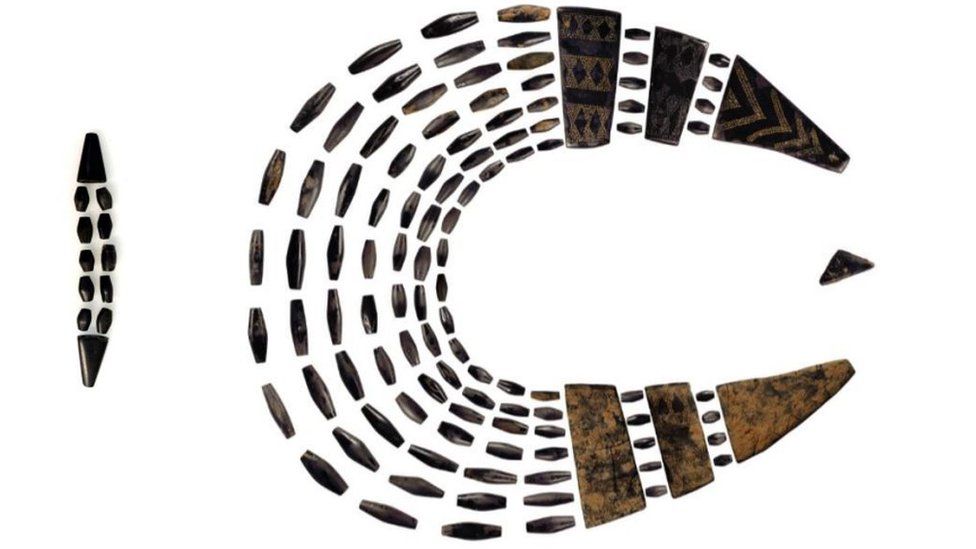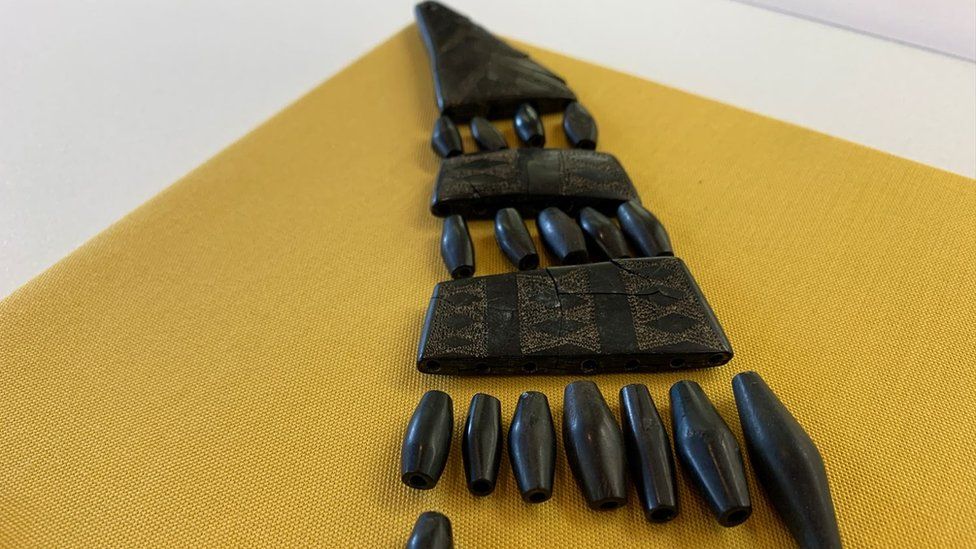
Perfectly preserved gagate jewellery in a Bronze Age burial mound
Categories: Nálezy nejenom s detektorem ve Velké Británii a Irsku
A unique, beautifully crafted 4,000-year-old necklace was discovered during an archaeological dig on the Isle of Man in 2019. The jewellery was made up of 122 black amber beads in seven rows above each other. It has now been declared a treasure and will be displayed for the public to see.
The set of gagate beads was found on the west side of the Isle of Man during the 'Round Mounds of the Isle of Man' archaeological project, which focuses on Bronze Age burial practices. The four-year research project was a collaboration between the Universities of Leicester and Newcastle with support from Manx National Heritage (MNH). The necklace is the first find of its kind on the island. It was uncovered along with human remains in a circular barrow.
Gagate is a dark and flammable mineraloid similar in composition to charcoal, which was formed by the decomposition of wood under high pressure. In the UK it was mined around Whitby. It has also been found in Neolithic graves in Bohemia. It was popular from prehistoric times through the Roman period and into the Middle Ages. It has been attributed with magical protective powers.
"The beads date back to the Early Bronze Age around 2,000 BC," said Allison Fox, curator of the MNH's archaeology department. "They've undergone careful cleaning and conservation because black amber is a relatively fragile material prone to splitting. However, even though they have been in the ground for so long, we can see them almost perfect. We were hoping to find pottery and also some other artefacts such as flint. But none of us really expected artifacts of this quality."
All 122 of the beads were part of an intricately decorated crescent-shaped necklace, with another section of beads forming a similarly styled bracelet. The seven-row necklace apparently came from a workshop in the Whitby area of North Yorkshire. "The discovery proves that the island (Man) was part of the society and community of the Irish Sea coast," explained Allison Fox. And she added that the jewellery was "probably very valuable" in its time and certainly personal to the buried woman. "I think she was a highly placed and respected figure within the community."
Although the necklace was discovered complete, conservation of some of the beads is still underway. It will be on display in the gallery of the Manx Museum in Douglas.
Roman Nemec
Sources: bbc.com, itv.com, canadatoday.news

General view

Detail of the decoration

In situ
For the landowner, researching the mound was a fascinating experience

The necklace was discovered in a cairn grave about 2 m from the top of the mound

The necklace was made up of seven rows of beads
The article is included in categories:
- Archive of articles > Archaeology > Finds and rescue research abroad > Nálezy nejenom s detektorem ve Velké Británii a Irsku
Post
Někde už jsem viděla článek, kde psali o jantaru. Na fotkách byly černé kousky, tak mě to dost překvapilo, jantar nebývá černý, ale pokud jde o gagát, jak je tu psáno, tak to leccos vysvětluje... Ale vidím poprvé, že by byl gagát přirovnán k jantaru. Jde v podstatě o něco jako přírodní asfalt, případně transformované dřevěné uhlí za specifických podmínek.... Ale vyhráli si s tím, vyrobili krásný náhrdelník, to se musí nechat.







